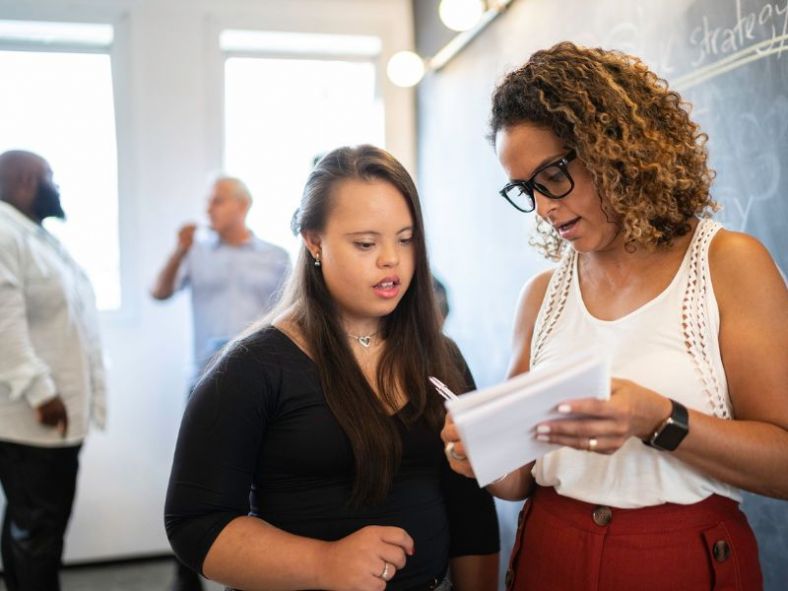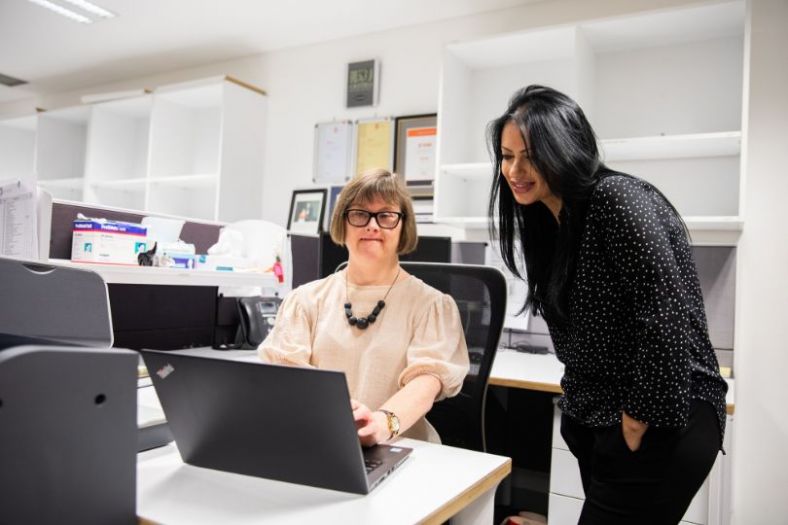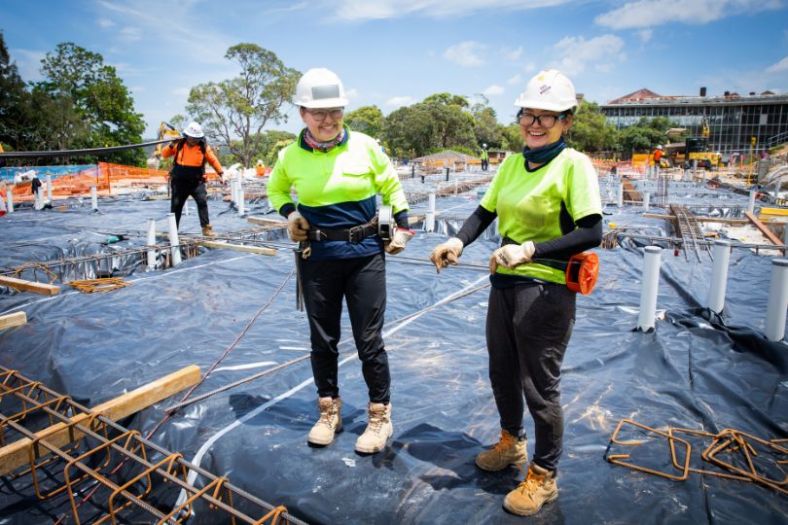Download or print
Request accessible format of this publication.

There is increasing alignment of career expectations between young women and men; women want jobs with opportunities for progression and not to have to choose between having a career and having a family.2,3
Despite this, women continue to have lower levels of economic participation and security compared to men. In 2021, working-age women in New South Wales (aged 15–64) In 2021, the average workforce participation rate for working-age women in New South Wales was 74 per cent, compared to 82 per cent for men.4
Women are also more likely to be employed in part-time or casual work compared to men.5
Women typically earn less compared to men over their lifetimes, which results in women retiring with significantly less superannuation than men.6
The COVID-19 pandemic heavily impacted women’s education and employment opportunities, exacerbating the impact of these pre-existing inequalities.
Women were more likely to lose their jobs and hours of work compared to men, while the workloads of predominantly-women frontline health and education roles intensified.7
Many women also became responsible for more unpaid work during this period, including supporting remote learning.8
Women in Western Sydney were particularly affected by the pandemic, with the labour force participation gap between women in South-West Sydney and Greater Sydney almost tripling between February 2020 and May 2021.9
Increasing women’s economic opportunities not only benefits women, but also their families and
the NSW economy.
Lifting the rate of women’s paid workforce participation to equal men’s over the next 20 years would increase employment growth and lead to an NSW economy that is 8 per cent larger by 2061; the equivalent of increasing household income by $22,000 (in 2019–20 dollars).10
In 2018, KPMG estimated that if the labour force participation gap were halved between men and women, Australia’s Gross Domestic Product (GDP) would increase by $60 billion over the next 20 years.11
Supporting women’s engagement in the workforce is also critical to address labour shortages across many industries, helping to ease supply constraints.
This will also lift the State’s economic productivity by ensuring we do not lose the benefit of women’s education, skills, creativity and enterprise.
The number of jobs vacancies reported in New South Wales rose by 63.9 per cent in the past two years, from 79,300 in February 2020 to more than 130,000 in February 2022.12
The combination of these factors means that there is no better opportunity than now to take action to improve women’s economic opportunities throughout their lifetime.
This Statement sets out the NSW Government’s plans to make New South Wales the best place in Australia for women to live, work and raise a family.
It draws on the findings of the Women’s Economic Opportunities Review (the Review), which was established by the NSW Government in February 2022 to consider how to improve women’s economic security through increased economic participation over the next five to 10 years.
The Review was supported by an Expert Reference Panel chaired by Sam Mostyn AO, President of Chief Executive Women.
The Expert Reference Panel provided subject matter expertise and advice that informed the Review, including a letter to the NSW Government that can be found on NSW Treasury’s website.
In line with the NSW Government’s Women’s Strategy, which identifies economic opportunity and advancement, health and wellbeing, and participation and empowerment as priority areas for action, this Statement sets out the following five strategic priority areas for reforms that the NSW Government plans to undertake, which are fundamental to increasing women’s economic opportunities and lifelong economic security.
1. Increase women’s workforce participation: supporting more women to enter and stay in the workforce and take on more full-time roles, including by improving access to affordable early childhood education and care.
2. Improve the experience of women in the workforce: closing the gender pay gap, reducing industry segregation and supporting more women to progress into leadership positions.
3. Support women in small business and entrepreneurs: increasing the number and success rates of women-led small businesses and start-ups.
4. Support and raise awareness of women’s health needs: investing in specific health needs of women over their working lives.
5. Respect for women and women’s financial security: preventing harassment and violence against women in the home and workplace, and supporting victim-survivors of domestic and family violence.
The Statement also addresses barriers faced by diverse groups of women with lower levels of workforce participation.
It is important to harness the strengths of diverse cohorts of women, including First Nations women, women from culturally and linguistically diverse backgrounds, women with disability, women with low socio-economic status and women from regional areas.
These strengths enable them to make valuable contributions to their families, communities and workplaces.
Together, the reforms set out in this Statement seek to address some of the largest barriers that have long limited women’s economic opportunities, from affordable childcare to stopping sexual harassment in the workplace.
The Statement covers a wide range of issues that affect women from many walks of life, and lays the foundations for ongoing investment by the NSW Government in women’s economic opportunity into the future.

Remove barriers to working
Remove barriers faced by women looking to enter, re-enter, and remain in the workforce.
Promote shared care
Actively promote more equal sharing of caring responsibilities between men and women.
Champion women in business
Address the specific challenges faced by women looking to start and run a small-business or start-up.
Foster women’s health
Boost support and raise awareness of health challenges faced by women throughout their working lives.
Recognise diversity as a strength
Recognise the strengths of diverse groups of women, while responding to specific challenges they face in the workforce.
Women’s safety is essential
Take action to prevent harassment and violence against women and support women who experience domestic and family violence.
Lead the way
The NSW Government should act as a leader and promote best practice across the public service and its suppliers
1. Increase women’s workforce participation
Supporting more women to enter and stay in the workforce and take on more full-time roles, including by improving access to early childhood education and care.
2. Improve the experience of women in the workforce
Closing the gender pay gap, reducing industry segregation and supporting more women to progress into leadership positions.
3. Support women in small-business and entrepreneurship
Increasing the number and success rates of women-led small-businesses and start-ups.
4. Support and raise awareness of women’s health needs
Investing in some of the specific health needs of women over their working lives.
5. Respect for women and women’s financial security
Preventing harassment and violence against women in the home, on the street and in the workplace and supporting victim-survivors of domestic violence.
This Statement seeks to address some of the biggest barriers that have long limited women’s opportunity, from affordable childcare to stopping sexual harassment in the workplace.
The Statement covers a wide range of issues that affect women from many walks of life, and lays the foundations for ongoing investment in women’s opportunity in future NSW Budgets.

Improving access to early childhood education and care
$1.7 billion towards introducing universal pre-kindergarten
$1.3 billion fee relief for preschool
$775.0 million towards boosting accessibility and affordability of childcare
Supporting women to return to the workforce
$32.0 million in grants and wraparound support for women to return to work
Boosting access to before and after-school care for all families
$37.9 million of targeted support in regional and rural locations
Women in construction
$20.2 million towards achieving 15 per cent women in construction by 2030
Safe workplaces
$9.7 million SafeWork taskforce to reduce sexual harassment in the workplace
Promoting greater sharing of caring responsibilities
Enhancements to public sector paid parental leave arrangements
Safer cities
$30.0 million for lighting, CCTV and foot traffic upgrades and an anti-street harassment campaign
No wrong door
$43.6 million for wraparound support for DV victims
AV links for DV complainants
$18.0 million for expanding AV links to allow remote evidence
NSW investment over 10 years $16.5 billion to improve women’s opportunities and child development

Supporting women in business
$11.5 million to provide tailored support to help women build and grow their businesses
Improving women’s access to venture capital funding
$12.0 million towards the Carla Zampatti venture capital fund for start-ups led by women
Government procurement
$3.7 million to monitor the proportion of women-led businesses in government procurement and promote equitable practices in businesses
Financial literacy
$3.5 million for women to build their financial literacy and business start-up skills.
Affordable fertility treatments
$80.0 million support for families with the high cost of fertility treatments
Support for menopause
$40.3 million for menopause hubs to care for women experiencing or who have experienced menopause
Female-friendly sport facilities
$25.0 million upgrading lighting and building female change rooms at sporting grounds
Post-natal mental health
$5.2 million to extend support for postnatal mental health services delivered by NGOs
Shared-equity scheme
For low-income single parents and older singles
Support for DV complainants
$8.0 million for court-appointed questioners for cross-examinations of DV complainants
Shared-equity scheme
For low-income single parents and older singles
Figures in tables, charts and text may have been rounded and are presented over four years unless otherwise disclosed.
Fostering cultural change to embed equality amongst men and women in all settings, will produce benefits for the NSW economy and community.
Affordable places
Affordable childcare supply boosted by about 47,000 places
Cost of living – Western Sydney
Middle-income family with one child who benefit from the State’s investment are expected to save up to $3,900 a year on childcare costs
Cost of living – regional NSW
Middle-income family with two children who benefit from the State’s investment are expected to save up to $7,800 a year on childcare costs
Women in the workforce
Up to 47,000 more women added to the workforce within 10 years
Up to 48,000 women switching from part-time to full-time work within 10 years
Growth in economic activity
NSW economic activity increased by up to $17.1 billion within 10 years
Household GSP
Household income increased by up to $4,400 for a year within 10 years
The increase in places and economic growth benefits are projected to be achieved from the early childhood education and care reforms in this package together with the proposed changes to the Child Care Subsidy committed to by the Commonwealth Government at the 2022 Federal Election.
Further detail on the modelling projections is included at page 68 of the PDF and the Methodology and References section online.
The cost of living estimates are dependent upon the final design of the Affordable and Accessible Childcare and Economic Participation Fund, market dynamics, and interactions with Commonwealth assistance.
Request accessible format of this publication.